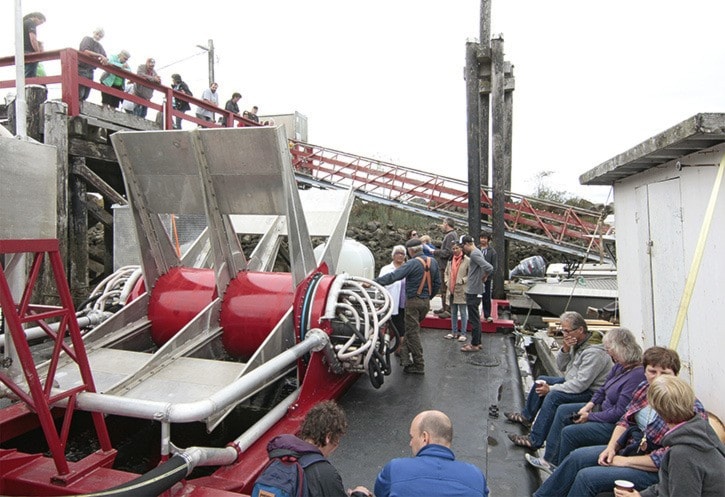Big wheel, keep on turning.
A tide-powered water pump invented by islander Laird Bateham is set for a test in Juskatla Narrows.
Four years after coming up with the idea, Laird joined his brother Alden, machinist Dan Abbott, and business manager Clyde Greenough last week to show people their small-scale prototype by the Port Clements dock.
Called Yourbrook Energy Systems, the homegrown Haida Gwaii company got a $280,000 grant from the National Research Council of Canada.
The rest of the $600,000 prototype is largely self-funded.
“We’re not book-trained,” joked Abbott, who helped Laird build the 1:10 scale model.
“So we don’t know it can’t work.”
The concept is pretty simple.
When the tide flows, it turns a big, slow paddlewheel that drives a piston pump.
The pump pushes fresh water through a closed loop of pipes, generating enough pressure to run the same kind of turbine found in a hydro dam.
Mount it all on a barge in the fast-flowing Juskatla Narrows, and the result is clean electricity — enough to get northern Haida Gwaii off diesel power.
“The inlet has 35 km2 of surface area, and that tide is flowing back and forth through that narrow channel, four times a day,” said Laird.
But what happens when the tide goes slack?
That’s where another step comes in — pump the water up a hill.
“We would pump water up a hill on the Begbie peninsula, up to about 900 feet,” said Greenough, explaining how a full-scale model would work.
Once the water fills a reservoir up top, the hill works like a giant battery.
“That water will come back down and drive a conventional turbine, just like any old hydro plant.”
“That’s the key thing,” said Greenough.
“This will generate firm power.”
If Haida Gwaii were connected to the B.C. power grid, Greenough explained, they wouldn’t need “firm,” or constant power — the pump could produce electricity only when the tide is flowing, and the grid would cover the rest.
But because Haida Gwaii is off grid, they need the reservoir to keep the lights on at slack tide.
When the prototype is anchored in Juskatla Narrows later this month, it will not pump water up to a reservoir.
For testing, the team will simply push water through a small loop and watch exactly how the pump speed adjusts with the changing tide.
Inside a tall steel box on the prototype is a computer that monitors tide flow and adjusts the pump speed to keep constant pressure.
Like everything else on the prototype, the computer is custom-made, designed by the islands’ own Geoff Hyatt.
“Everything you see here was built on Haida Gwaii,” said Greenough, adding that eventually, Yourbrook hopes to manufacture the tidal pumps on island and export them around the world.
Besides firm power, one of the system’s big selling points is that unlike most tidal-power turbines, the paddlewheel is neither high-speed nor underwater.
“It’s slow-turning,” said Abbott.
Turning at half the tide flow, Abbott the paddlewheel only makes three to six revolutions per minute, maybe 10 rpm if freewheeling.
Installed over a rocky part of Juskatla Narrows, that means the paddlewheel poses little danger to fish or other marine life.
And floating on the water surface, it’s also much less costly to maintain.
“The whole idea of this thing was to make it tough, simple, so that logs could go through it, and it won’t kill the fish,” said Abbott.
If all goes smoothly, Yourbrook may be able to build a working demonstration model at Juskatla Narrows as early as three years from now.
Doing that would require a contract with the Council of the Haida Nation and BC Hydro, not to mention a 10 km transmission line and a substation at Port Clements.
It’s a big leap, but Yourbrook has already defied expectations by coming up with a model for Haida Gwaii tidal power that be far less costly to build than the $40 million forecast by the province a few years ago.
Asked how he came up with the idea without any formal training, Laird said much of it came from working on his Maude Island farm, where he built a mini run-of-river hydro system.
“A lot just comes from practical experience, from working on the ocean, from towing log booms through tidal rapids,” he said, adding that Dan Abbott also brought a lot to it from his experience running the Abfam sawmill.
“There are people who are just born engineers.”
